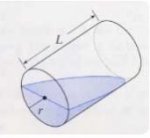A cylindrical glass of radius r and height L is filled with water and then tilted until the water remaining in the glass exactly covers half the base.
In what direction can you "slice" the water into triangular cross-sections? Rectangular cross-sections? Cross-sections that are segments of circles?
Find the volume of water in the glass

In what direction can you "slice" the water into triangular cross-sections? Rectangular cross-sections? Cross-sections that are segments of circles?
Find the volume of water in the glass

Last edited:

